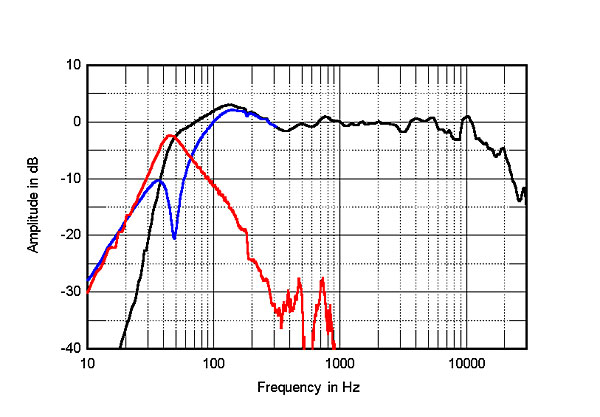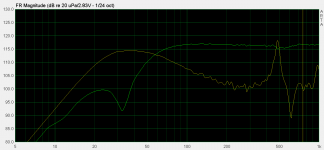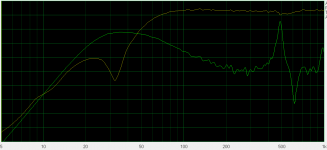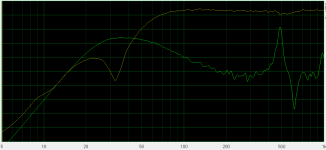use D, the important thing is the volume of air in the port, and D, being the average diameter, should give the closest result to calculating that.
An what I found interesting about mic position:
"Mic in the center of vent at baffle surface if vent is not rounded. If vent has rounding, penetrate few millimetres inside, where tube with constant diameter begins. Not too deep."
"Mic in the center of vent at baffle surface if vent is not rounded. If vent has rounding, penetrate few millimetres inside, where tube with constant diameter begins. Not too deep."
I have to say, I've never had very good luck with the formulas. It could very well be my own lack of experience, and the like, so I end up using far-field to validate my calculations.
It's not so simply. What in this situation?no need to calc, just align the low end responses for port to woofer
https://www.diyaudio.com/forums/attachment.php?attachmentid=827861&stc=1&d=1585212152
There are three options:
https://www.diyaudio.com/forums/attachment.php?attachmentid=827862&stc=1&d=1585212628
https://www.diyaudio.com/forums/attachment.php?attachmentid=827863&stc=1&d=1585212628
https://www.diyaudio.com/forums/attachment.php?attachmentid=827864&stc=1&d=1585212628
Which is correct? 🙂
Attachments
The air turbulence noises should be audible in the nerfield, you should look a more adapted one, like those that JBL have putted in the K2 S9800.
If I have flared port like on the attached picture and need to scale his response to speaker nearfield which dimension should I use in scaling formula? E or D?
I guess your goal is to scale the sound output (SPL) from the port in order to merge it with the woofer output, correct? If so, the scaling depends on the sound emitting surfaces. For the woofer, this is the effective cone (piston) area, Sd. For the port, it's the effective cross-sectional area at the end of the port. With your flared port I'd say you should use E or C, which is the "effective diameter" at the end of the port (not D, which is the diameter somewhere along the inside of the port). But then again it's not so clear what the effective diameter at the end of a flared port really is.
As an alternative, I'd recommend the "microphone in box" technique to determine the bass response of a bass-reflex system. This technique provides a direct measurement of the total (summed) output of the woofer and the port, so there is no need to measure the woofer and port separately and then merge the two.
The Microphone-in-Box technique is described here (you need to scroll down a bit): Measuring Loudspeaker Low-Frequency Response | audioXpress
The original publication with more details (and absolute SPL scaling) is: R H Small. Simplified loudspeaker measurements at low frequencies. Journal of Audio Engineering Society (JAES), 20:28–33, 1972
Last edited:
I have to say, I've never had very good luck with the formulas. It could very well be my own lack of experience, and the like, so I end up using far-field to validate my calculations.
Low-frequency measurements in the far field require an anechoic room or a very large tower to move the speaker and the microphone away from any walls or other reflective surfaces. Not easy.
I guess your goal is to scale the sound output (SPL) from the port in order to merge it with the woofer output, correct?
Yes, It is.
As an alternative, I'd recommend the "microphone in box"
I think it's a lot of work with this technique and it's inconvenient. Additionally I have bent tunnel with 90 degree elbow.
There's another technique described here:
https://www.klippel.de/fileadmin/kl...39_Merging_Near_and_Farfield_Measurements.pdf
Putting mic close to the baffle between speaker and port. But it works only if you have port and speaker on the same plane.
It's not so simply. What in this situation?
https://www.diyaudio.com/forums/att...-port-response-speaker-nearfield-unscaled-png
There are three options:
https://www.diyaudio.com/forums/att...scaling-port-response-speaker-nearfield-1-png
https://www.diyaudio.com/forums/att...scaling-port-response-speaker-nearfield-2-png
https://www.diyaudio.com/forums/att...scaling-port-response-speaker-nearfield-3-png
Which is correct? 🙂
I have not checked your links but second graph looks most correct 😎
I think it's a lot of work with this technique and it's inconvenient.
Uhm, not at all! All you have to do is to put the microphone inside the box, and take the measurement. It's less work than two nearfield measurements (woofer, port), which then need careful merging, and in the end you're not sure if the merging is correct.
Additionally I have bent tunnel with 90 degree elbow.
Is this a press-fit port that can be unmounted easily? If so: take it out, put the microphone in the box, with the wire going through the port, and reinstall the port. Then take the measurement. Done.
Hi mbrennwa,
Is this measurement technique the same as you used on the Monkey Box build? If so, it seems like an awesome method to avoid making guesses in how much to scale port when splicing. I’m building a larger stand mount currently that has (2) ports on front baffle and it’s nearly impossible to do an accurate near field measurement of woofer without interference from the ports. This method would solve that problem.😀
Best Regards,
Rich
Is this measurement technique the same as you used on the Monkey Box build? If so, it seems like an awesome method to avoid making guesses in how much to scale port when splicing. I’m building a larger stand mount currently that has (2) ports on front baffle and it’s nearly impossible to do an accurate near field measurement of woofer without interference from the ports. This method would solve that problem.😀
Best Regards,
Rich
Yes, I used this for the Monkey Coffin. It works with any number of radiators (woofers, ports). The original Small paper is a good read (I have a PDF copy).Hi mbrennwa,
Is this measurement technique the same as you used on the Monkey Box build? If so, it seems like an awesome method to avoid making guesses in how much to scale port when splicing. I’m building a larger stand mount currently that has (2) ports on front baffle and it’s nearly impossible to do an accurate near field measurement of woofer without interference from the ports. This method would solve that problem.😀
Best Regards,
Rich
Hi mbrennwa,
Is it possible for you to post that Small paper? I would love to give it a read.😀
Best,
Rich
Is it possible for you to post that Small paper? I would love to give it a read.😀
Best,
Rich
Hmmm, I had to buy the paper from the AES, and I guess it's possibly not okay to post the PDF for free access. But, wait, it was published 48 years ago, so maybe... aehm, I have no clue. It's probably best if you send me a PM with your email.
Joe D' Appolito wrote a excellent article in audioxpress about methods of low frequency measurements (including Near field and Microphone-in-the-box measurement).
The article is posted on line here:
Measuring Loudspeaker Low-Frequency Response | audioXpress
The article is posted on line here:
Measuring Loudspeaker Low-Frequency Response | audioXpress
- Home
- Loudspeakers
- Multi-Way
- Scaling port response to speaker nearfield





